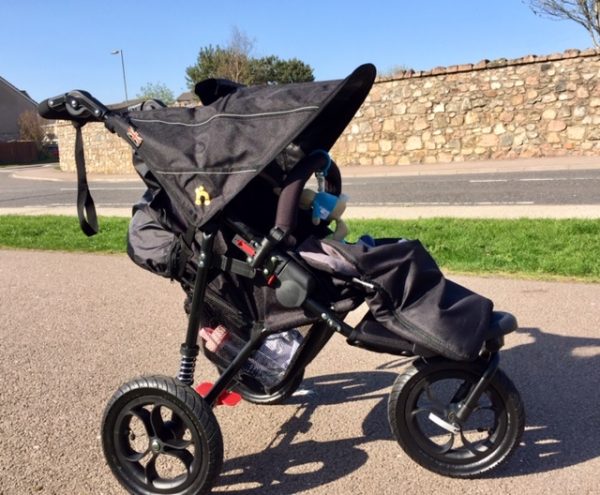If you’re a runner, returning to running postnatally is probably something you asked even before your baby was born! Running is one of the easiest exercise forms to fit in around mum/baby life and has the added benefit of blowing off any psychological/mental steam that your newly consumed life may bring.
Returning to running postnatally should be a gradual process and there are now new evidence-based guidelines (1) that have just been published so you can ensure you are properly fit to run after the birth of your baby, whether this was a few weeks ago or a few years ago!
When can you consider postnatal running?
This is the million dollar question! But the reality of the answer is quite complex! The correct, safe time to run postnatally is different for everyone. Generally, guidelines do not advise running less than 3 months postnatally. This is because your body needs time to heal. The surrounding muscles (pelvic floor & abdominals in particular) are greatly stretched and weakened during pregnancy and birth too and these require time to reduce & strengthen again. Evidence shows that even at 12 months, with rehab, they have not returned to pre-pregnancy standards. Read “All you need to know about your pelvic floor” here.
Running produces a huge & sudden intra-abdominal pressure (pressure inside your abdomen, which then presses on your internal organs such as your pelvic floor). This creates strain to your body, as well as drawing on other regions to compensate for the lack of postnatal strength. Naturally, your gluteals (bottom muscles), muscles around your hips, and legs will all have declined during pregnancy and need gentle exercise to strengthen them up first so that they can support the effort of running, and provide better shock absorption and transfer of this through the body. Otherwise. inadequate muscles bear the brunt of this load and it can lead to injuries. Your core muscles are the powerhouse in this load transfer system, therefore strength must be returned to your trunk/core/pelvic floor prior to running.
So the answer to “when can you return to postnatal running?” is dependent on when the above factors are considered. Try the safety checks below for a basic guide, and seek further help when required!
What else should we consider before running postnatally?
When considering returning to exercise postnatally, the physical aspects are usually emphasised. Making sure you’ve had the “6 week all clear” from your G.P, feeling more comfortable without pain etc however these “checks” are not deemed thorough enough and do not consider the FULL effects of having a baby. We need to consider the whole body in a holistic approach because having a baby is not just a physical event, it effects you hormonally and mentally too. It has done for the 9 months throughout your pregnancy too so these effects are a huge aspect of your health to consider, and should only be completed by a qualified postnatal physiotherapist.
Sleep deprivation
The inevitable with a new baby! On a serious note, sleep deprivation is real postnatally. Sleep loss causes a reduction in muscle protein synthesis and impairs maximal muscle strength. This means your body is already at a disadvantage by not being able to efficiently repair minor muscle strains (which occur with any exercise) and gain strength as you would have previously. These factors leave you exposed to increased injury risk. Run when you’ve had some sleep, or reduce running distance and frequency to stay safe when you’re lacking in ZZZZZ.
Psychological health
A lot of people run to relieve stress! And it’s a fantastic, proven way to beat stress! New mums will definitely be subject to various forms of stress & anxiety when learning life with their new baby; however this can pre-expose them to over exercising or pushing too far with running. When time is scarce, and therefore very precious when you do get that freedom there is the tendency to cram in as much as possible or run as far/hard as able. The pressure of “getting back to it” post-baby is also a real pressure many women face. Whether its for stress relief, to return to “normal” hobbies, or to feel fit again the pressure remains. Go easy on yourself. Start gentle, slow, and short distances. Build up when you feel physically, and mentally ready to prevent physical injury or mental burn out.

Breast feeding
Breast feeding mums can feel the discomfort in their chests depending when they last fed baby and how full they are. Ideally aiming to feed or express some time prior to your run can ensure you stay comfortable for longer, as well as wearing a well supported sports bra that fits your current size. Be aware that breast feeding also prolongs the duration of Relaxin (the hormone that relaxes your body during pregnancy) in your body therefore you will generally be more lax than normal and potentially subject to strains if you overdo it.
Wound care
A c-section wound can take time to heal, and once healed on the outside may not be fully healed on the inside just yet. Vaginal deliveries can create wounds you maybe aren’t fully aware of, as well as those that require stitches or interventions. Be considerate of your body’s trauma wherever it is and go easy on the duration of run, length of stride, speed of run, & impact on the ground. Rest plenty afterwards too.
Safety checks prior to running postnatally
The best way to be sure you’re ready to run is to have an assessment with a postnatal physiotherapist. They can individualise their advice to you based on your body and current state. Here are some test criteria you should be able to complete from the new guidelines to give you an idea if you’re “ready” (but this does not replace a proper assessment):
Pelvic floor muscle endurance test
10 x fast contractions
8-12 x of 6-8 second maximal contractions
1 x 60 seconds 30-50% contractions
Load & impact management
These tests should be completed without pain, heaviness, dragging, or leaking:
- Walking 30 minutes
- Single leg balance 10 seconds
- Single leg squat x10 on each leg
- Jog on spot 1 minute
- Forward bounds x10
- Hop on the spot x10 each leg
- Single leg “running man”; opposite am and hip movements with a bent knee x10 each side
Strength tests
These tests should be completed with x 20 of each test without any issues:
- Single leg calf raise
- Single leg bridge (see photo below)
- Single leg sit-to-stand
- Side lying abduction (raise top leg up& down)

Abdominal screening
This should be completed by a qualified postnatal physiotherapist for a comprehensive review. These tests can evaluate the ability of your abdominals to take load and transfer it properly. There should be NO doming/sinking/pain/strain to your abdominal region:
- Lie on your back with knees bent and take your chin to your chest
- Lie on your back and raise one leg upwards to approx. 30 degrees, keeping knee straight (straight leg raise)
- Sitting upright rotate your trunk to the side against resistance (someone stopping you)
What to watch out for during your run
There are several things you may experience during your run that are not “normal” for running and should be discussed with a postnatal physiotherapist. They can provide you with good advice, tips, and a full assessment if required. Seek help if you experience any of the following during your run:
- Heaviness/dragging feelings in your vagina region
- Leaking at any stage of your run, or afterwards too
- Bulging/doming/straining at your abdominal region; or any discomfort afterwards
- Pelvic pain (at the front, back, or sides) or lower back pain
- On-going or an increase in blood loss >8 weeks postnatally
Buggy running
Purchasing my running buggy was one of the turning points in my postnatal fitness journey, and a life saviour for finding time to run! Read more about it in my Fitness and Healthy Lifestyle Update. There is now evidence to support buggy running and it suggests the benefits far out way the risks. Running with both hands on the handle bar is suggested to be kinder on your body and provides a speed & stride length similar to non-buggy running. Minor changes can occur to the pelvis and hip biomechanics, however no issues are found further down to the knees and ankles. One-handed running can cause excess rotation at the pelvis and further changes through the whole trunk, hips, and subsequent body compensations.

Safety tips for buggy running
- Ensure baby is strapped in tight with the 5-point harness system
- Use the hand strap/safety strap around your wrist at all times
- Use both hands on the handle bar
- Ensure the handle bar is at the correct height for you; shoulders should be relaxed, elbows slightly flexed, wrists neutral
- Keep your back up straight, chest lifted, shoulders back & relaxed down, and neck long
- Avoid gripping the handle bar too tightly
- Run slower than normal when going downhill to increase control over the buggy, and prevent excess downhill pressure on yourself
- Be wary of running up steep hills initially; pushing a pram whilst running uphill takes excess effort and you may not be ready for this just yet!
- Try to engage pelvic floor and core as a warm up for 2-3 minutes and remind yourself of this a few times throughout the run
References:
- mail chi.mp/38feb9423b2d/returning-to-running-postnatal-guideline. Authors Tom Goom, Emma Brockwell, Grainne Donnelly.




